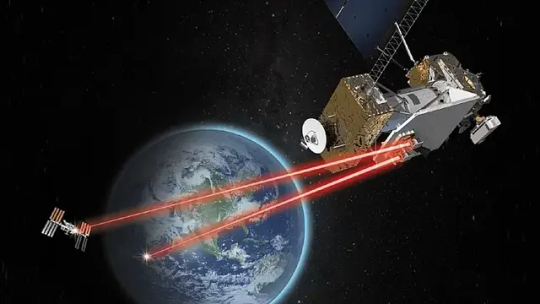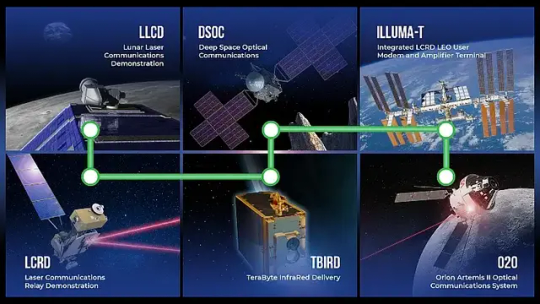#SpaceStationDataTransfer
Explore tagged Tumblr posts
Text
Laser Communications Revolution: NASA Space Breakthrough

Advancing Laser Communications
In a remarkable display of cutting-edge technology, NASA is embarking on a mission to revolutionize data transmission from the International Space Station (ISS). The ILLUMA-T (Integrated Laser Communications Relay Demonstration Low Earth Orbit User Modem and Amplifier Terminal) payload will launch this November. It will showcase how laser communications enhance missions in low Earth orbit, clearing the path for scientific breakthroughs and exploration expeditions. Harnessing the Power of Infrared Light Laser communications, employing invisible infrared light, is poised to make a significant impact on the transmission of data. This breakthrough technology allows spacecraft to transmit and receive information at much higher data rates, granting them the ability to send copious amounts of data back to Earth in a single transmission, ultimately expediting discoveries for researchers.

NASA’s ILLUMA-T payload was delivered to SpaceX Dragonland. Photo by SpaceX. NASA.
ILLUMA-T: A Space Communications Game-Changer
Operated within NASA's Space Communications and Navigation (SCaN) program, ILLUMA-T pioneers a groundbreaking bi-directional, end-to-end laser communications relay. It collaborates with NASA's Laser Communications Relay Demonstration (LCRD), which embarked on its mission in December 2021. Together, ILLUMA-T and LCRD are laying the foundation for a new era in communication innovation. Currently, LCRD demonstrates the remarkable advantages of laser communications from geosynchronous orbit by transmitting data between two ground stations on Earth and conducting a series of groundbreaking experiments. Unveiling LCRD's Potential The LCRD experiments encompass a range of initiatives, including the examination of atmospheric effects on laser signals, verification of LCRD's ability to collaborate with multiple users, testing network capabilities like delay/disruption tolerant networking (DTN) over laser links, and the enhancement of navigation capabilities.
ILLUMA-T's Optical Module
ILLUMA-T's optical module comprises a telescope and a two-axis gimbal, enabling precise pointing and tracking of LCRD in geosynchronous orbit. Moreover, the compact optical module, compact, roughly the size of a microwave, and the payload itself, equivalent in size to a standard refrigerator, facilitate advanced space communication. The Data Relay Process Once installed on the exterior of the ISS, ILLUMA-T will facilitate the relay of data from the space station to LCRD at an impressive speed of 1.2 gigabits per second. LCRD will then transmit the data to optical ground stations in California or Hawaii. Following this, the data will route to NASA's LCRD Mission Operations Center at the White Sands Complex in Las Cruces, New Mexico. Engineers at NASA's Goddard Space Flight Center in Greenbelt, Maryland, will then verify the accuracy and quality of the data sent through this end-to-end relay process.
Paving the Way for Enhanced Data Transmission
"Illuminating" the potential of laser communications, ILLUMA-T, and LCRD are poised to transform space communications capabilities. Following the experimental phase with LCRD, ILLUMA-T could become an integral part of the space station, significantly increasing the volume of data NASA can send to and from the orbiting laboratory. Revolutionizing Space Communications While the space station has historically relied on radio frequency relay satellites for data transmission, laser communications have the potential to be a game-changer for researchers on Earth conducting experiments aboard the ISS. In fields ranging from biological and physical sciences to technology and Earth observations, astronauts conduct research for the benefit of humanity. ILLUMA-T offers the capacity to significantly enhance data rates for these experiments, capable of sending the equivalent of an average movie's worth of data in under a minute, at an astounding speed of 1.2 Gbps.

NASA’s Laser Communications Roadmap – proving the technology’s validity in a variety of regimes. Photo by Dave Ryan. NASA.
A Leap Forward in Space Communications
This monumental ILLUMA-T / LCRD end-to-end laser communications relay system represents a crucial step forward in space communications capabilities. In conjunction with past and upcoming demonstrations, NASA is highlighting the transformative potential of laser communications systems for both near-Earth and deep space exploration. A Future of Laser Communications The goal of these demonstrations is to seamlessly integrate laser communications as a capability within NASA's space communications networks—the Near Space Network and Deep Space Network. Mission planners interested in leveraging laser communications are encouraged to reach out to [email protected].
Advancing Space Communications Through Innovation
NASA's Laser Communication Initiatives The ILLUMA-T payload, funded by the Space Communications and Navigation (SCaN) program at NASA Headquarters in Washington, is under the management of NASA's Goddard Space Flight Center in Greenbelt, Maryland. The project enjoys collaborative support from the International Space Station program office at NASA's Johnson Space Center in Houston and the Massachusetts Institute of Technology (MIT) Lincoln Laboratory in Lexington, Massachusetts. LCRD, spearheaded by Goddard in collaboration with NASA's Jet Propulsion Laboratory in Southern California and the MIT Lincoln Laboratory, receives funding through NASA's Technology Demonstration Missions program, which falls under the Space Technology Mission Directorate, and the Space Communications and Navigation (SCaN) program at NASA Headquarters in Washington. Sources: THX News & NASA. Read the full article
#CommunicationBreakthroughs#ILLUMA-TandLCRD#ILLUMA-TMission#InfraredLightBenefits#LaserCommunicationRevolution#LaserCommunications#LaserTechnologyAdvancements#NASALaserRelay#SpaceDataTransmission#SpaceStationDataTransfer
0 notes